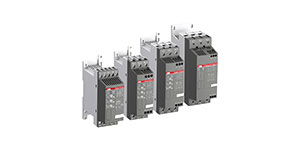Frequently Asked Questions For ABB Low Voltage Soft Starter
ABB Low Voltage 12th Dec 2022
 Main contactor
Main contactorQ: Is there any requirement to put a main contactor in series before the softstarter?
A: The softstarter does not require any main contactor but we recommend the use of one for emergency stop and/or trip of the overload relay. In some applications an MCCB can be used instead of the main contactor.
Ambient temperature
Q: Can I use a softstarter if the ambient temperature is higher than the recommended value during operation?
A: The softstarter can normally be operated at a higher ambient temperature during operation if the rated current for the unit is derated according to the manufacturer’s recommendation.
Thyristor shorted
Q: Is it possible to run a softstarter with one thyristor shorted?
A: Yes, it is possible but not for all types of softstarters.
Soft stop applications
Q: What applications are suitable for soft stop?
A: Pumps and conveyor belts loaded with fragile products are the two main applications suitable for soft stop.
Advantages of by-pass
Q: What are the advantages of using by-pass?
A: Reduction of power loss. It is also possible to reduce the enclosure size and use a higher IP-class since air ventilation is not required.
Power loss
Q: What is the power loss of a softstarter during a continuous run?
A: The values can normally be found in the catalogue. For ABB softstarters the following formula can be used (for example for PS S 18...300):
PLtot = [3 x Ie x 1.0] + 50 (W) reduced to 50 W only which is the power of the cooling
fans when using by-pass. Ie is the operational current of the motor.
fans when using by-pass. Ie is the operational current of the motor.
Utilisation category
Q: What utilisation category should be used for the main contactor and the by-pass contactor?
A: Main contactor: always use AC-3.
By-pass contactor: it is possible to use AC-1.
By-pass contactor: it is possible to use AC-1.
Fault indication when starting
Q: Why does the softstarter indicate a fault when the start signal is given to the main contactor and softstarter at the same time?
A: If the main contactor is closed too late the softstarter will indicate this as a phase loss fault. Delay the start signal to the soft starter by approx. 0.5 sec. to solve this phenomenon.
Test without motor
Q: Can I test a softstarter without using a motor?
A: No, this is not possible since there will be no current going through the softstarter and some types will also indicate loss of load.
Overload relay trips during start
Q: Why does the overload relay trip during start?
A: Possible reasons can be one of these or in a combination:
- too low current limit
- too long ramp time
- too low initial voltage
- wrong tripping class on the overload
- wrong setting on the overload
Separate overload relay when using by-pass
Q: Do I need a separate overload relay when using a softstarter with built-in electronic overload and by-pass?
A: If the current transformers of the softstarter can be installed so that the measuring can be performed when by-passed a separate relay is not required; otherwise yes.
Different frequency
Q: Can I use the same softstarter at both 50 and 60 Hz?
A: It is possible with all type of ABB softstarters as long as the curve is sinusoidal.
Voltage fluctuations
Q: What voltage fluctuations are allowed for the softstarters?
A: The minimum and maximum value where we can guarantee full function is -15 % to
+10 % of the rated value. This is also stated in the IEC-standard.
+10 % of the rated value. This is also stated in the IEC-standard.
Example: 400 V - 15 % to +10 % ≥ 340 V - 440 V range.
Semi-conductor fuses
Q: Do I always have to use semi-conductor fuses?
A: When using semi-conductor fuses a type 2 co-ordination can be achieved.
It is possible to use an MCCB (moulded case circuit breaker) or MMS (manual motorstarter) instead but then with a type 1 co-ordination. For a more in-depth description see the chapter on co-ordination.
It is possible to use an MCCB (moulded case circuit breaker) or MMS (manual motorstarter) instead but then with a type 1 co-ordination. For a more in-depth description see the chapter on co-ordination.
12th Dec 2022

